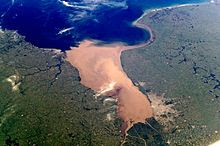- Most estuaries were formed during the Holocene epoch by the flooding of river-eroded.
- An Estuary is a fully enclosed body of water along the coast.
- Freshwater from;
rivers
streams
- It meets & mixes with salt water from the ocean.
- Estuaries transition from land - sea.
- They are protected from;
-Ocean waves
-Winds
-Storms
 |
| River Nith estuary |
Estuarine are;
1. The most productive on earth.
2.Creating more organic matter each year than comparably-sized areas of forest.
3.Grassland
4.Agricultural land.
 |
| River Exe estuary |
- About 60% of the world's population living along estuaries and the coast.
- Estuaries support unique communities of plants & animals especially adapted for life at the margin of the sea.
- Different habitat found in estuaries, including
shallow open waters
freshwater and salt marshes
swamps
sandy beaches
mud
sand flats
rocky shores
oyster reefs
mangrove forests
river deltas
tidal pools
seagrasses
- Estuaries provide places for recreational activities, scientific study, & aesthetic enjoyment.
- Thousands of species of birds, mammals, fish, wildlife depend on estuarine habitats as places to live, feed, and reproduce.
- estuaries provide ideal areas for migratory birds to rest and re-fuel during their long journeys.
- Because many species of fish and wildlife rely on the sheltered waters of estuaries as protected spawning places, estuaries are often called the "nurseries of the sea."
 |
| Río de la Plata estuary |
- Estuaries uplands carries;
sediments
nutrients
pollutants to estuaries.
 |
| amazon estuary |
- The filtration process creates cleaner and clearer water, which benefits both people and marine life.
- Wetland plants and soils act as natural buffers between the land and ocean.
- Absorbing flood waters and dissipating storm surges.
Classification on geomorpology;
1.Drowned river valleys
2.Lagoon type
3.Bar built type
4.Fjoord type
 |
| Estuary of the Klamath River in Northern California |
Classification on water circulation
1.Salt wedge
2.Partially mixed
3.Vertically homogenous
4.Inverse
5.Intermittent
 |
| Estuary mouth |


.jpg)
.jpg)

.jpg)
.jpg)
No comments:
Post a Comment